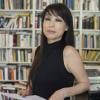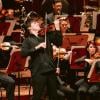
“Not all ears hear in the same way,” Claude Debussy wrote in response to a negative review of La mer. Complaining that he couldn’t hear (or see or smell) the sea, a critic had panned not only the performance but the piece itself. These ears adore Debussy’s score, but still they couldn’t catch the sound of the sea in the San Francisco Symphony’s performance with conductor Ryan Bancroft on May 16.
These symphonic sketches, composed between 1903 and 1905, have different priorities than those of a symphony. Debussy’s piece doesn’t develop so much as it materializes — in snapshots simultaneous and strikingly contemporary. In his SF Symphony debut, Bancroft, like many newcomers to Davies Symphony Hall, seemed to have trouble with sonic balance. Especially in the second movement, you often got the sense that you were hearing the wrong things.
And there’s much to take in. Every measure of La mer vibrates with meaning, as does every cell of Katsushika Hokusai’s The Great Wave, the woodblock print that Debussy so admired and had recreated on his score’s cover. Moments of Thursday’s performance did have fine sweep — the dance of the lower strings in the first movement, for example. Only what of the intricacies, the colors? In Debussy’s music, melody should come first, but in this performance, it was engulfed.

The 19th-century violinist-composer Henri Vieuxtemps, on the other hand, isn’t remembered for his melodies — nor for much at all. The most singable bits of his Violin Concerto No. 5 come from someone else’s opera, and episodes of the piece seem as if they were filled in after the fact. So why choose this concerto? Well, length: Vieuxtemps condensed the traditional three-part concerto into a breathless single movement. That left room enough on the SF Symphony’s program for Kevin Puts’s Earth, one of the pieces from The Elements, a violin suite commissioned by Joshua Bell that features the work of five different composers.
And thank goodness Bell commissioned Puts so that we could hear the Vieuxtemps reinvigorated. As music director of the Academy of St Martin in the Fields, Bell soloed at Davies last month on Felix Mendelssohn’s Violin Concerto. But it was for this slighter work by Vieuxtemps — heavier lifting — that we really needed him. Bell played so fluidly that even the rote passagework felt capricious. Not every note spoke fully, but it all tumbled out with the kind of excitement you would have talking to the person you’d been waiting for your whole life. In fact, under Bancroft’s baton, the orchestra couldn’t quite keep abreast in the little it had to play. The lively first section was sometimes more raucous than refined. But what a hushed chord the orchestra sustained waiting for the soloist to start.
A ceremonial air filled the hall during Unsuk Chin’s Alaraph ‘Ritus des Herzschlags’ (Alaraph, ritual of the heartbeat) — not only because this was the United States premiere. At 20 minutes in length, Alaraph is a sizable commission for SFS and a grand score in a greater sense. The rhythm rarely leaves its promenade, but the notes zoom past. It’d take subsequent listens to track the piece’s arc — and its references. Chin, whose orchestral works Graffiti and subito con forza have recently appeared at the SF Symphony, here touches on Korean traditional music and astronomy.
Space may be freezing, but Chin’s score is as warm as a rainforest. A battalion of cymbals splashes, the accordion makes a shuddery vaudeville, but the traditional cohorts, too, stretch and swell in sensuous combinations you couldn’t dream of.




